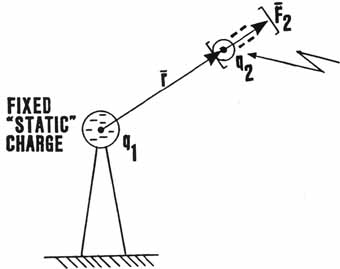 |
A NEGATIVELY CHARGED TEST MASS [e.g., AN ELECTRON] BROUGHT INTO THE VICINITY OF q1 EXPERIENCES A FORCE ELECTRON ACTUALLY IS SPINNING. THIS HAS NEVER BEEN DONE WITH A TRUE "STATIC CHARGE", FOR THERE IS NO SUCH THING IN NATURE. |
SLIDE 5.
FORCE BETWEEN TWO LIKE CHARGES
 |
A NEGATIVELY CHARGED TEST MASS [e.g., AN ELECTRON] BROUGHT INTO THE VICINITY OF q1 EXPERIENCES A FORCE ELECTRON ACTUALLY IS SPINNING. THIS HAS NEVER BEEN DONE WITH A TRUE "STATIC CHARGE", FOR THERE IS NO SUCH THING IN NATURE. |
In
my presentation last year, I noted some 22 fundamental flaws in present
electromagnetics theory. One of these flaws was in the actual
vector theory itself. As we shall discover, one cannot simply plug
geometrical vectors into physical systems without making fundamental
errors. The vector concept itself must be adapted, for there are
now four different kinds of vectors in physics, all confused as the same
thing. We will come to that shortly. |